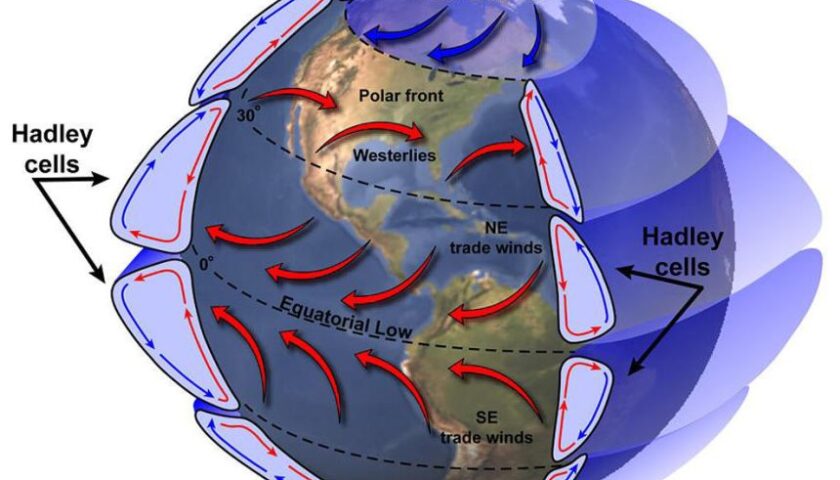On a clear sky, one time or other you would have seen white contrails streaking across the sky. As if sky blue is canvas for these aircrafts or as if they are announcing true love, up high where our dreams meet. They look beautiful to one and all except for military pilots for they point like signposts. On some occasion they disappear in seconds on other they persist for very long after aircraft has passed. What are these white contrails and how are they formed?
Contrails are aircraft condensation trails that appear as line shaped clouds int the sky. It is a type of ice cloud, formed by aircraft as water vapour condenses around small dust particles, which provide the vapour with sufficient energy to freeze. The formation of contrail ice particles starts at microscopic scales when extremely small soot or other particles form in the aircraft combustion exhaust through a process in which a few tens to hundreds of molecules come together and grow to larger sizes by sticking together. Further growth may occur by condensation of water vapor present in exhaust gases on the particle surfaces made up of compounds such as sulfates and nitrates. Subsequent growth of particles happens due to ambient relative humidity that exceeds 100%.
Contrails were initially discovered during the first high-altitude flights in the 1920s, although scientists and engineers were not overly concerned with them until WWII, when military aircraft could be seen from miles away due to the long lines of contrails left in their wake.
Contrails are easily identifiable in the sky behind a jet-engine aircraft at the head of the trail. Contrails can form within a few wingspans of the aircraft behind the exhaust and can dissipate within a short distance from the engine exhaust because of the lack of available water vapour in the atmosphere.
The critical temperature, below which Contrails may form (MINTRA, minimum trail), is approximately -24°C at Sea Level and -45°C at 50,000 feet. However, the heat generated by the engine raises the temperature in the wake of the aircraft and consequently lowers the relative humidity so jet aircraft do not necessarily generate contrails unless the temperature is approximately 15°C below the MINTRA temperature. In broad terms, Contrails are more likely to occur in warm Tropical Maritime air masses with a high but cold tropopause, whereas Contrails are less likely to be seen in cold, polar air masses with a low, relatively warm tropopause.
There are three different families of contrail, but all are made from the same two components and formed in the same way. The primary difference is the amount of time the contrail remains visible. The first of the three,
Short-Lived Contrails, appear as short white lines following along behind the aircraft, although disappear quickly – almost as fast as the airplane goes across the sky. Typically, Short- Lived Contrails survive for just a few minutes at most before the water vapour sublimates back into gas. In this scenario, the air mass through which the aircraft flies is quite dry with only a small amount of water vapor available to form the contrail.

Persistent (Non-Spreading) Contrails are presented as long white lines that remain visible long after the airplane has passed. A prerequisite for this type of contrail is a wet, humid atmosphere, with a large amount of water vapour/nuclei available to form the contrail. Due to the additional moisture, the ice takes much longer to sublimate, allowing the contrail to remain visible for up to an hour after the aircraft has passed. Also, the time the contrail is visible and the speed of the wind in the upper atmosphere often cause contrails to move from where they originated and have been known to travel many miles.
Persistent (Spreading) Contrails are formed in an identical way to the non-spreading variety. However, the spreading occurs due to the air mass being unstable or turbulent. This turbulence dissipates the dense contrail lines and spreads them over a wide area, giving them a more cloud-like appearance.
How are Contrails different from wingtip vortices?
Wingtip vortices are often thought to be a type of contrail but are actually produced from a different process. During very specific weather conditions you may see vapour trails form at the rear of the wingtips of jet aircraft on takeoff or landing. This phenomenon occurs due to a decrease in pressure and temperature as the wing generates lift.
How do contrails differ from other types of clouds?
Unlike clouds which form naturally, contrails are technically manmade clouds since they are formed due to the exhaust from an airplane. Also, contrails are nearly always made of ice crystals, unlike natural clouds which are often liquid water in suspension. Finally, they can only form at very high altitudes where the air is extremely cold, whereas natural clouds can form anywhere, from very close to the ground (fog), to very high altitudes (cirrus clouds).
Hazards
Since a Contrail indicates where an aircraft has been, their existence may be an indication of potential Wake Vortex Turbulence.



